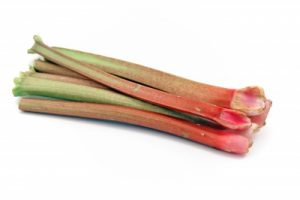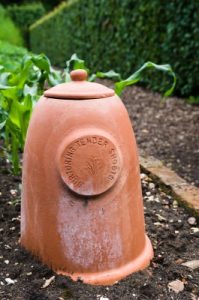Rhubarb (Rheum x hybridum)is a lovely perennial plant for any gardener who wants a reliable, easy to cultivate plant with broad statuesque leaves for grandeur. It is one of the earliest of all crops – remember it is a vegetable not a fruit ! The stems are delicious in a crumble with enough sugar just to reduce the tartness. In the UK as in Europe, we have a vast array of varieties for growing. Take your pick but find one that has a good reputation for flavour.
Forcing For Early Cropping
Forcing helps to produce earlier crops in March. The terracotta forcers are some of the best ornaments in the vegetable patch. Most crops are ready from the end of April onwards until mid-summer as most plants stop producing new growth. An alternative method is to spread a layer of straw or bracken over the crowns in December/January. Cover with an upturned bucket to then exclude light. The best cultivars for this are ‘Timperley Early’, Champagne, Grandad’s favourite (AGM) and ‘Stockbridge Arrow’.

Put rhubarb into the ground immediately after it has been divided. Water appropriately although don’t over do it as rotting can occur. However, during drought it is necessary to water efficiently, making sure the soil remains moist so growth can continue.
If you are placing several crops in the same area then check that they are spaced appropriately so they can grow to a decent size – this should be a distance of around one metre between specimens and 1-2m for the spacing between rows.
Confirm there are no weeds present around your crop – a mulch can be added around the base to prevent this. If you do not have enough space in your garden, rhubarb can also be grown in large containers more than 50cm in diameter and depth.
You have to wait until the second year after planting before you can harvest produce as doing so before this will affect the specimen’s robustness. To harvest take hold of the stem near the base, then twist and lightly pull – do not take all the produce at once.
All rhubarb crowns need to establish well before full cropping can commence but remember as we stated before, do not take any crops in the plant’s first year. Harvest only lightly in the second year.
New cultivars such as ‘Livingstone’ and ‘Poulton’s Pride’ do not need summer dormancy and will continue to produce new growth well into autumn. Cropping is best reduced or stopped during very hot and dry periods in the summer. In spring, after the first flush of growth, all plants should be kept well watered. Apply a top dressing of a high-nitrogen granular fertiliser or forse manure to encourage a good second flush of growth.
There is increasing interest in the nutraceutical properties of rhubarb. Recent research has looked at an association with treatment for certain types of cancerous cells.

Varieties:-
cv. Champagne. The early variety and one for forcing. An old reliable type which produces pale pink, thin stems which are fantastically sweet. Starts producing sufficient stems for harvesting after two years. Make sure it has rich soil. See Ken Muir (T: 0044 1255 830181).
cv. Fulton’s Strawberry Surprise. AGM. A maincrop rhubarb with super flavour for cooking and fantastic coloured stems in bright red. Voted ‘Best-flavoured Rhubarb’ in the RHS Wisely trial. A strong pant but not to over-vigorous for the garden. Can be tried in containers. See King’s Seeds. T: 01376 570000 www.kingsseeds.com
cv. Goliath. Huge variety in terms of yields producing bumper crops year on year. Apparently, one plant will produce 5kg of stems per crown. Highly reliable and excellent for forcing. Find seeds at Marshalls Seeds (www.marshalls-seeds.co.uk).
cv. Livingstone. No summer dormancy and crops into autumn. Good crop of red stalks with great flavour.
cv. Poulton’s Pride. No summer dormancy. Crops into autumn. Rosy-red stalks with exceptional flavour.
cv. Raspberry Red. early AGM cultivar. Produces high quality rich red stalks without forcing but forcing improves the flavour. heavy cropper and very reliable.
cv. Rosenhagen. A low oxalic acid producing plant so good for feeding children. see Marshalls Seeds. T: 0844 5576700 www.marshalls-seeds.co.uk
cv. Thompson’s Terrifically Tasty. An early yielding crop which is often ready for cutting in March. Long cropping period and the stems can be cut into mid-summer. See Pomona Fruits (T: 01255 440410, www.pomonafruits.co.uk)
cv. Timperley Early. early AGM cultivar. Thick stems, early cropping and high yield. Good garden cultivar and probably the most common. Suited to forcing. Stem bases are red, grading to green. The colour is better when forced.
cv. Victoria. Claimed to be a cultivar with a balance of acidity and sweetness. the stems are light green and pink which provides a subtle colouring to any dessert. Big cropper for year on year harvesting. (See Pennard Plants, T: 01749 860039 www.pennardplants.com)
Leave a Reply